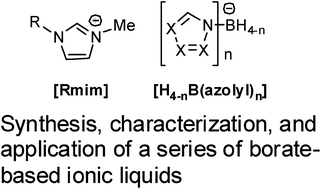Synthesis and characterization of imidazolium poly(azolyl)borate ionic liquids and their potential application in SO2 absorption†
Abstract
Thirteen new 1,3-substituted imidazolium poly(azolyl)borate salts with the general formula [R1R2im][B(H)4−n(azolyl)n] (R1 = methyl, n-butyl, 2-(diethylamino)ethyl; R2 = methyl; azolyl = pyrazolyl, imidazolyl, 1,2,4-triazolyl, tetrazolyl; n = 2, 3) have been synthesized through salt metathesis of the corresponding imidazolium chloride and potassium poly(azolyl)borates. The newly synthesized dihydrobis(azolyl)borate and hydrotris(azolyl)borate salts are liquids at room temperature except two of the 1,3-dimethylimidazolium derivatives, [mmim][H2B(pz)2] and [mmim][HB(pz)3]. Conductivity, thermal and physicochemical properties of the new borate ionic liquids were systematically investigated. With multiple azolyl groups serving as binding sites, these ionic liquids (ILs) generally exhibit high SO2 absorption capacity (up to 5.8 mol mol−1 of IL or 1.05 g g−1 of IL for 1-methyl-3-n-butylimidazolium hydrotris(imidazolyl)borate, compound 13).


 Please wait while we load your content...
Please wait while we load your content...